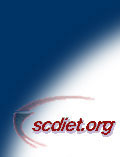|
|
|
|
Chapter
One provides the reader with an understanding of the challenges
faced by Elaine Gottschall and her daughter when traditional
medicine failed them, and how they overcame these challenges.
|
|
 |
 Chapter One - Past and Present
Chapter One - Past and Present |
In
1951, after many years of clinical experience, Drs. Sidney
V. and Merrill P. Haas published a book entitled Management
of Celiac Disease. Directed to the medical community,
the book documented the doctors' experiences in treating and
curing hundreds of cases of celiac disease as well as cases
of cystic fibrosis of the pancreas. Their approach was dietary,
and they used a well-balanced, normal diet that was highly
specific as to the types of sugars and starches allowed. When
patients followed this Specific Carbohydrate Diet for a minimum
of one year, they were then able to return to normal diet
with complete and permanent disappearance of symptoms.
In
1958, we took our eight year old daughter to the Drs.
Haas. Three years before she had been diagnosed by specialists
as having incurable ulcerative colitis and her condition
was deteriorating. The years of treatment with cortisone
and sulfonamides, plus innumerable other medical approaches,
had been unsuccessful and surgery seemed imminent. The
Drs. Haas placed her on the Specific Carbohydrate Diet
and within two years she was free of symptoms. She returned
to eating normally after another few years, and has
remained in excellent health for over twenty years.
Many
students, friends, and others whom I have seen in my
practice who were suffering from ulcerative colitis,
Crohn's disease, celiac disease (not cured by a gluten-free
diet), diverticulitis, and various types of chronic
diarrhea have tried the Haas Diet and most of them are
now free of their respective diseases. Some of the most
dramatic and fastest recoveries have occurred in babies
and young children with severe constipation and among
children who, along with intestinal problems, had serious
behavior problems. These included autistic-type hyperactivity
as well as hyperactivity, often accompanied by severe
and prolonged night terrors. Very often the behavior
problems and night terrors cleared up within ten days
after initiation of the Haas Specific Carbohydrate Diet.
It is interesting to note that in June, 1985, the Schizophrenia
Association of Great Britain launched a research project
to investigate Dr. F. C. Dohan's research concerning
a relationship between celiac disease and schizophrenia.
The basis for this project is a strict grain-free, milk-free,
low sugar diet, closely related to the Specific Carbohydrate
Diet.
Meanwhile
in research laboratories throughout the world, investigators
have been studying intestinal problems. Physicians and
researchers have found that a special type of synthetic
diet (chemical nutrients assembled in the laboratory)
called an Elemental Diet shows great promise in the
treatment of digestive and intestinal problems of all
types. The malabsorption problem seen in cystic fibrosis
of the pancreas as well as diarrhea which occurs after
cancer chemotherapy have been overcome by the use of
the synthetic Elemental Diet. When used for patients
with Crohn's disease, not only did symptoms disappear
but children who had not grown properly for years showed
dramatic weight and height gains while on the diet.
The level of sodium chloride in the perspiration (the
sweat test which measures the severity of the condition)
of children with cystic fibrosis of the pancreas decreased
dramatically when these children were given the Elemental
Diet. Over six hundred scientific publications have
appeared in medical journals in the 1970's and early
1980's testifying to the fact that this Elemental Diet
is effective in correcting malabsorption and reversing
the course of many intestinal disorders. However, since
the Elemental Diet is an artificial diet, usually administered
via a stomach tube, it cannot be continued indefinitely.
When it is discontinued, usually after six to eight
weeks, improvement gradually decreases and symptoms
usually return.
The
common denominator underlying the effectiveness of both
the natural Specific Carbohydrate Diet and the synthetic
Elemental Diet is the type of carbohydrate which predominates.
In the synthetic Elemental Diet, the principal carbohydrate
is the single sugar, glucose, which in biochemical circles,
is called a monosaccharide (mono=one; saccharide=sugar)
as contrasted with a two-sugar disaccharide such as
sucrose (table sugar) or a many-sugar polysaccharide
such as starch.
In
the natural Specific Carbohydrate Diet, the carbohydrates
are also predominantly single sugars - those found in
fruit, honey, properly-made yoghurt, and certain vegetables.
The many research reports indicating that the synthetic
Elemental Diet is beneficial in intestinal diseases
provide support for the Specific Carbohydrate Diet which
can be used in the home.
Those
who choose to follow the Specific Carbohydrate Diet
need not feel deprived. Many of the delicious recipes
in this book could easily be part of any gourmet cookbook.
The fact that they are so appealing, however, in no
way compromises the underlying scientific reasoning:
the carbohydrates specified in the recipes are biochemically
correct.
The
Specific Carbohydrate Diet presented in this book is
highly nutritious and well-balanced. It is safe and
very likely to be effective in overcoming many lingering
and vexing intestinal and digestive problems.
|
|
|

